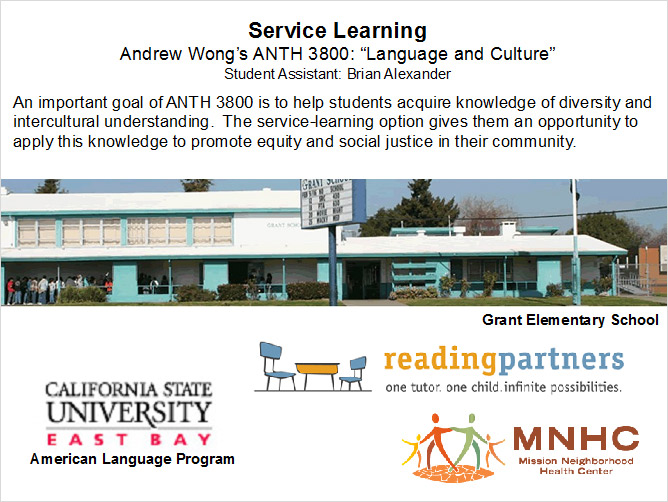Recipe for a Service-Learning Option:
-
I have been teaching ANTH 3800 (Language & Culture) almost every quarter since I came to CSUEB in Fall 2008. In this course, students are exposed to different approaches to the study of language and culture and learn how these approaches can help us better understand and avoid intercultural miscommunication. They also acquire knowledge of diversity and social justice through discussion of language-related social issues – e.g., gender miscommunication, bilingual education, the English Only Movement, and the Ebonics controversy in Oakland in the 1990s. Last quarter, I created a service-learning option to give students an opportunity: (1) to apply this knowledge to "real-world" situations; and (2) to promote diversity and social justice in their community.
-
There are excellent resources for faculty who are interested in service learning. Mary D'Alleva, who is our Director of Community Engagement, is always willing to help. From my experience, I have learned that planning a service-learning option involves the following steps, all of which must be completed before the course starts:
- Identify organizations that offer relevant service-learning opportunities. The Center for Community Engagement maintains a list of service learning program partners. Identify 8-10 organizations that are suitable for your course. Run your list by Mary D’Alleva and other faculty who have taught service-learning courses. They will be able give you useful insights into what it is like to work with these organizations and help you narrow down your list. Don’t give students more than five options. Some students find it difficult to make up their minds when they have too many to choose from.
- Work closely with your organizations. Contact them well ahead of time. Make sure that they are willing to work with you and your students and that your service-learning option is compatible with their volunteering opportunities. Some organizations require volunteers to undergo extensive training. It may be difficult for your students to complete the training and the required number of service hours in just ten weeks.
- Develop a set of meaningful reflective assignments. I assigned a pre-service reflection, a during-service reflection, and a post-service reflection. All three were designed to help students think about how to use what they had learned in class at their service placement. At the end of the quarter, students presented to the rest of the class what they had learned and how they had used their knowledge of linguistic diversity and intercultural understanding to promote equity and social justice in their community. The Center of Community Engagement has sample syllabi and many great ideas for reflective assignments.
-
Here are some tips for faculty who are interested in developing a service-learning option:
Give students firm deadlines. I required students to complete 10 hours of volunteer service. To make sure that they would be able to start as soon as possible, I told them to secure a service placement and turn in a service learning plan by the end of Week 3. Students who were unable to do so did a term project and a weekly blog assignment instead.
Get to know your service learning partners. Some organizations have established programs for volunteers and know exactly what they want students to do, but others don't. Some are more responsive and hands-on than others. Get to know your service learning partners, so that you can anticipate problems that your students may run into in the future.
Be flexible. Check in with your students from time to time to make sure that they will be able to complete the required number of hours. Problems are bound to happen. Be ready to offer alternatives if your students run into problems beyond their control. Last quarter, a student of mine volunteered at a speaking partner program for English learners. Her partner stopped showing up after Week 5. Her phone was disconnected, and she did not respond to any of my student’s emails. Luckily, I was able to find another speaking partner for my student.
Do a "soft launch". It is a good idea to offer service learning as an option if it is your first time incorporating service learning into your course. You will be able to learn from experience and work out the kinks before making it a requirement. Unfortunately, some students are under the impression that service learning courses require extra work. Offering service learning as an option is a good compromise if you are worried about its potential adverse effect on enrollment.
-
My students' experience with service learning was generally positive. Last quarter, 9 of the 36 students in ANTH 3800 selected the service-learning option. Quite a few of them were aspiring teachers and social workers. Others just wanted to meet students from other countries and learn about their cultures. In their final presentations, students talked about how the class had encouraged them to become more aware and appreciative of their speaking partners' norms of communication, and how our discussion of non-standard dialects had helped them become better tutors by alerting them to the difference between reading errors and dialect features. They all appreciated the opportunity to give back to their community and gain valuable experience that would be helpful to their future careers. Because of their positive feedback, I decided to offer the service-learning option again this quarter.
